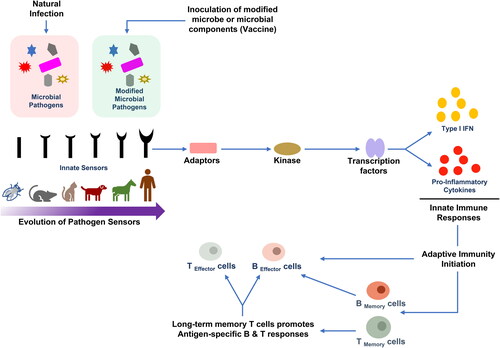Selection pressure of evolutionary dynamic microbial pathogen shapes the host genome to express an array of sensors to sense pathogen in various cellular compartments. The surveillance is initiated through the sensing of microbes by sensors, which induce antimicrobial innate immune factors and signal a cascade consisting of adaptors, kinase, and transcription factors. These responses eliminate pathogens and/or establish advanced microbe-specific immune responses. This issue of International Reviews of Immunology describes TLR family sensors adapted for sensing constantly-evolving pathogens in various hosts, and downstream modulation of transcription factor during host innate immunity. Additionally, the issue also describes the biology of vaccine against infectious diseases and dysregulation of pattern recognition receptors (PRRs)-mediated signal culminating to the development of immunopathology ().
The PRRs are a family of sensors which promptly sense invading pathogens and trigger innate immune responses. Among PRRs, toll-like receptors (TLRs) are extensively studied sensors that sense microbe on the cell surface and intracellular compartments, such as endosomes or endolysosomes. The first review article of this issue by Bagheri et al. discusses the evolution of TLRs in different terrestrial vertebrate species. The article also discusses how microbial infections influence the function of these TLRs in various species. This article will be useful to readers or researchers working on the interface of evolutionary biology and immunology for a better understanding of immune genes’ evolution, and subsequently hypothesizing the specialized function of genes in different species, which may be helpful in finding some novel functions of these TLRs in humans.
Interferon regulatory factors (IRFs) are a family of transcription factors consisting of nine members, which play a pivotal role in various immune cells through the expression of antimicrobial genes. These genes also play an important role in immune cells’ differentiation, apoptosis, and cell cycle. Among all IRFs, IRF5 are crucial for the innate immune responses through the induction of type I interferons and inflammatory cytokines. The second review article in this issue, by Kaur et al., describes the function of IRF5 in immunity, particularly in innate immunity and the consequence of dysregulation resulting in the development of immune disorders/autoimmune disease. The review also discusses the molecules which modulate IRF5 activity to induce immune responses. The review may be useful to the clinical researchers who are working in the field of clinical immunology, rheumatology, translational immunobiology, and immune disorders/immunopathology ().
Infectious diseases remain a major threat to human health. Recently the fundamental understanding of host–pathogen interactions have been tremendously enhanced, but still, microbial evolution leading to the generation of infectious microbes with epidemic and pandemic potential is practically unknown. Altogether, it is hard to predict the possibilities of future infectious disease outbreaks around the globe. Therefore, several strategies are urgently required to intervene in such outbreaks including the development of robust and rapid diagnostics, small molecule-based targeted therapeutics, and development of pan-vaccines for several related infectious microbes. The third review article in this issue by Bhurani et al. discusses the various aspects of vaccine biology, including the challenges associated with vaccines and the ability to induce B and T cell-mediated long-term immunity. The authors extensively discussed the importance of T cells in long-term immunity, and its impact on both B and T cell-mediated immunity. The authors proposed several points for the development of an ideal vaccine, which vaccine biologists may consider for new vaccine development ().
Seasonal Flu or Influenza virus infection causes pulmonary tract illness ranging from mild to severe symptoms and sometimes death of the infected patient. Even though a vaccine for flu is available, its ability to protect from infection varies from season to season due to variation in surface antigen through the phenomena of antigenic shift, drift, and genetic reassortment. The last review article of this issue by Looi et al. describes the pros and cons associated with the current influenza vaccine. The authors also describe the concept of a universal vaccine which may protect against different subtypes of influenza virus for a longer period. The review provides an overview of influenza virus vaccines and also suggest better vaccine strategies in light of current Influenza virus and host-influenza virus interaction biology ().
References
- Evolution and species-specific conservation of toll-like receptors in terrestrial vertebrates. Int Rev Immunol. 2018; 37(5):217–228.
- IRF5 mediated immune responses and its implications in immunological disorders. Int Rev Immunol. 2018; 37(5):229–248.
- Developing effective vaccines: Cues from natural infection. Int Rev Immunol. 2018;37(5):249–265.
- How far have we reached in development of effective Influenza vaccine? Int Rev Immunol. 2018; 37(5):266–276.

